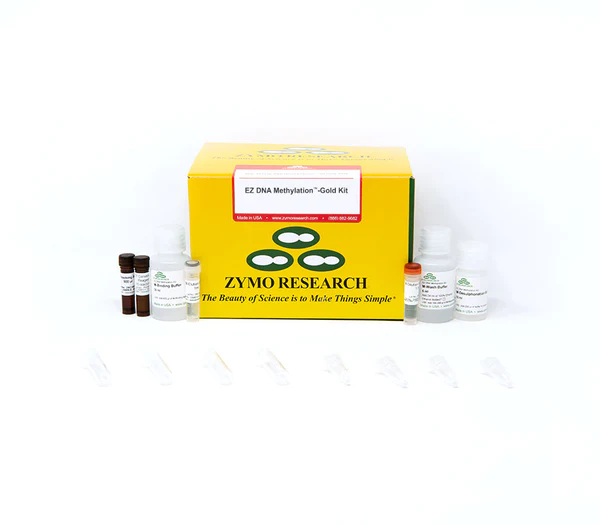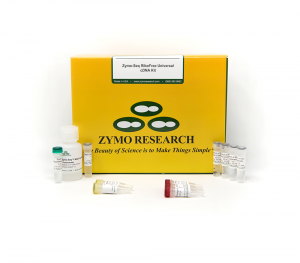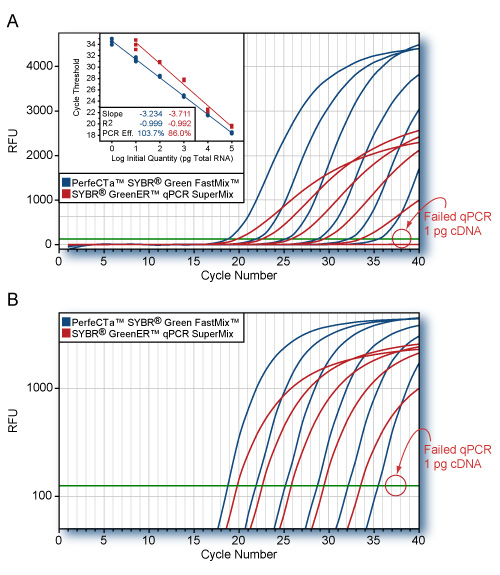EZ DNA Methylation Gold Kit
| Cat# | Name | Size |
|---|---|---|
| D5006 | EZ DNA Methylation Gold Kit | 200 Rxns |
Description
Highlights
- Complete bisulfite conversion of DNA in less than 3 hours.
- Desulphonation and recovery of bisulfite-treated DNA with a spin column.
- Recovered DNA is ideal for downstream analyses such as PCR, endonuclease digestion, sequencing, microarrays, etc.
Description
Applications
Purified, converted DNA is of high-quality and well-suited for downstream processes, including library preparation for Next-generation sequencing, PCR amplification, etc.
Conversion
>99%
Elution Volume
≥ 10 µl
Equipment
Microcentrifuge and thermocycler with heated lid
Input
500 pg – 2 µg of DNA.
Processing Time
3 Hours
Recovery
>75%
Sample Source
Purified genomic DNA, endonuclease-digested DNA, linearized plasmid DNA, etc. DNA should be high-quality and RNA-free.
Q1: Is an incubation with desulphonation buffer for longer than 20 minutes recommended?
Leaving the desulphonation buffer on the column longer than recommended will cause more degradation and subsequently result in lower yields.
Q2: Does bisulfite conversion only occur in a CpG context?
Bisulfite conversion will work regardless of context, so the kits are compatible with genomic DNA derived from plants and other species with high non-CpG methylation levels.
Q3: Which polymerase is recommended for amplification from bisulfite converted DNA?
ZymoTaq DNA Polymerase has been specifically designed for use in bisulfite amplification reactions. ZymoTaq is available as a stand-alone polymerase (E2001/E2002), PreMix (E2003/E2004), and qPCR PreMix (E2054/E2055).
Q4: What is the minimum DNA size that can be recovered?
> 50 bp.
Q5: How to quantify / visualize converted DNA?
Following bisulfite treatment of genomic DNA, nonmethylated cytosine residues are converted into uracil. The recovered DNA is typically A, U, and T-rich. The original base-pairing no longer exists. Instead, it is single stranded with limited non-specific base-pairing at room temperature. The absorption coefficient at 260 nm resembles that of RNA. Use a value of 40 μg/ml for Ab260 = 1.0 when determining the concentration of the recovered bisulfite-treated DNA. To visualize, run converted DNA on agarose gel then chill the gel on ice for 30 minutes. The expected smear will be between 100-1500bp.
Q6: What leads to poor conversion efficiency/ low yields?
Poor conversion efficiency and low yields can be due to a variety of different experiment-specific conditions. Please contact Technical Support to discuss your specific experimental conditions and further troubleshoot with a product specialist.
Q7: How long is bisulfite converted DNA stable at -20 °C?
Converted DNA should be eluted in M-Elution Buffer to keep the converted DNA stable for long term storage. If stored properly for long term (<-20C), the samples should last longer than a month. Minimize freeze/thawing to keep the bisulfite converted DNA stable.
| Cat# | Name | Size |
|---|---|---|
| D5002-4 | M-Wash Buffer | 24 ml |
| D5001-4 | M-Wash Buffer | 6 ml |
| D5001-5 | M-Desulphonation Buffer | 10 ml |
| D5002-5 | M-Desulphonation Buffer | 40 ml |
| D5005-2 | M-Dilution Buffer-Gold | 1.5 ml |
| D5006-2 | M-Dilution Buffer-Gold | 7 ml |
| D5005-3 | M-Binding Buffer | 30 ml |
| D5002-6 | M-Elution Buffer | 4 ml |
| D5001-6 | M-Elution Buffer | 1 ml |
| D5006-3 | M-Binding Buffer | 125 ml |
| D5005-6 | M-Dissolving Buffer | 500 µl |
| D5006-6 | M-Dissolving Buffer | 1.2 ml |
| C1001-50 | Collection Tubes | 50 Pack |
| C1004-50 | Zymo-Spin IC Columns | 50 Pack |
| D5001-1 | CT Conversion Reagent | 1 tube for 10 Conversions |









